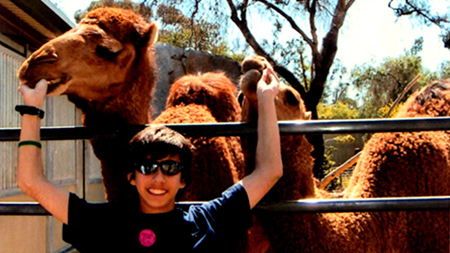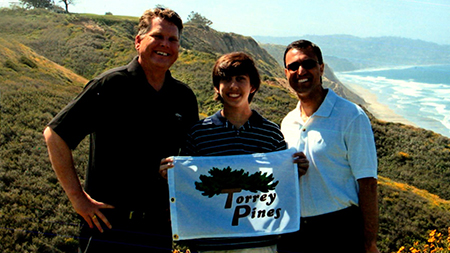Meet Nathan Natale, a 23-year-old studying to become a veterinarian.

When the phone rang at the Natale family home in Loudonville, New York, during the early morning hours of Jan. 12, 2013, Nathan Natale knew exactly what it meant.
“My little sister had someone sleeping over. And I was like, ‘hello parents of friend, we gotta go.’”
The phone call was from Boston Children’s Hospital. A donor match had been found. The Natales packed quickly, hopped in the car and began the three-hour journey to the hospital for Nathan’s kidney and intestine transplant. But Nathan’s transplant journey didn’t begin here. It began five years earlier.
An unexpected trip to the emergency room
At the tender age of 15, Nathan’s appendix ruptured, triggering a series of events that turned his world upside down. Complications from an appendectomy led to multiple organ failure. For the next three weeks, Nathan was in a medically induced coma.
“When I awakened I knew something had gone very wrong, but I didn’t want to dig too deep into what had happened. It was just too scary.”
One month later, Nathan was taken by MedFlight to Boston Children’s, where he underwent treatment to stabilize his failing organs.
“I started asking questions. ‘Why am I here?’ ‘Why can I not eat anything?’ Ultimately, they explained that a blood clot during the appendectomy had caused me to lose 80 percent of my small intestine. Every time I ate it passed right through me because I had no way to absorb it.”
Nathan remained in the hospital for eight months. His care team was hoping to rehabilitate his small bowel to a state where he could receive all his nutrition orally.
“We knew I needed a kidney transplant, but with a permanent catheter in place for IV nutrition the transplant team was very hesitant, because catheters — or any sort of line post transplant — are a major risk for infection due to the immunosuppression meds a transplant patient is placed on.”
During his recovery, the school provided tutors at the hospital and then at home, while he acclimated to dialysis, tube feeding and frequent trips to Boston. But despite everything, he managed to graduate in the top five percent of his class, while serving as class treasurer, a member of the chorus and a spokesperson for kidney disease awareness.

With Nathan’s nourishment coming from bags of intravenous fluid and three to four hours of dialysis each night, college was to be an even greater challenge than anticipated. Nathan realized two things: colleges are not equipped to accept large medical shipments, and dialysis is a less-than-desirable lab partner for a biology major.
“We ended up looking into home hemodialysis, and I ended up doing that for a year in my dormitory room prior to receiving the transplant.”
Nathan’s intestine was showing no signs of improvement. In early 2012, he underwent an isolated intestine and kidney transplant evaluation. “I decided to move forward with the transplant, which would allow for me to eat normally and receive my kidney without fear of infection.”
‘The two-for-one special’
Dr. Heung Bae Kim, director of the Boston Children’s Pediatric Transplant Center, and surgeon Dr. Khashayar Vakili performed the transplant surgery — which Nathan humorously calls ‘the two-for-one special’ — on the night of the NFL playoffs between Denver and Baltimore. Nathan remembers vividly because as the anesthesia began to slowly ease him to sleep, he was still watching the game, his mind not far from the gift he was about to receive.
“I was curious about the donor and yet I wasn’t. I wanted to be able to thank the family but it was a day of celebration in my family and a day of tragedy in theirs. So my feelings were conflicted.”
Nathan’s post-transplant experience has not been easy. Sometimes he feels as though he traded one set of burdens for another.
“I no longer have to do dialysis, but I have to make sure that I take this plethora of medications.”
On the other hand, the transplant has given him new freedom. He is able to swim again. When he had the permanent catheter, swimming was off-limits. And he says he can be more flexible with his friends.
“Now when a friend says, ‘Hey, Nate, want to go do xyz?’ Previously, when I was doing the home dialysis I had to say, ‘Sorry I am already hooked up to the machine, no can do.’ But now, at least, I have the option.”
What lies ahead
Every two to three months, Nathan visits Boston Children’s. He had hoped by now – nearly three years post transplant –
these visits would become less frequent, but a series of infections have forced him to return.
“I don’t heal as easily since I am immunosuppressed.”
A junior in college, Nathan is studying biology and hopes to be a veterinarian someday. He plans to graduate in the spring but if delayed, he’s OK with that too.
“I try not to stress myself too much. Sometimes I wonder if I made the right decision. But at the end of the day, it’s better than being hooked up to machines. With the transplant, I get to seize my life back again, and I am not just simply waiting and hoping.”
